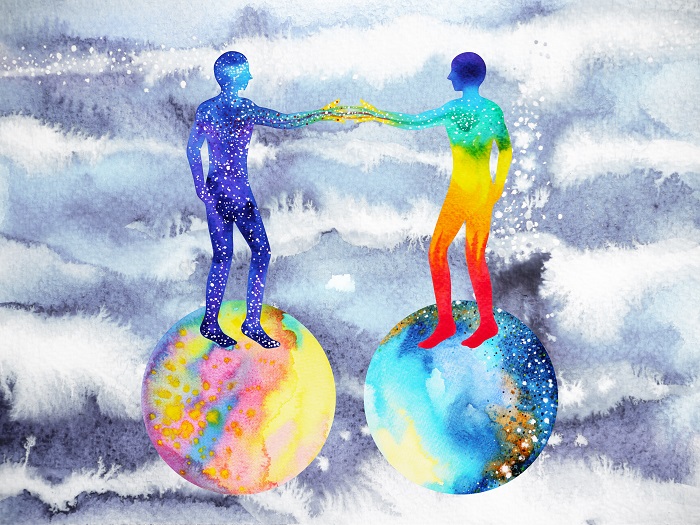Translated By Andrew Yang
Alaya dependent origination is a Buddhist theory of cosmic origin. According to this model, all dharmas in the universe owe their existence to the seeds contained in the Alaya consciousness of sentient beings, which are realized when causes and conditions suffice. As the saying goes, all the Three Worlds come from the mind alone, and all dharmas come from consciousness alone. The Mahayana Consciousness-only School classifies sentient beings’ consciousness into eight types: eye-consciousness, ear-consciousness, nose-consciousness, tongue-consciousness, body-consciousness, mental consciousness, Manas consciousness and Alaya consciousness.
The first five types of consciousness arise from the four sensory organs of the eyes, ears, nose, tongue plus the body otherwise and their respective objects in the external environment, i.e., colour, sound, scent, taste and sensations produced by touch, although they do not yet analyze nor differentiate stimulant triggers with discretion.
The sixth type of consciousness arises from the mind, hence the name. It has a cognitive capacity as well as faculties to trace, analyze, distinguish and predict all internal and external triggers of the past, present, and future. Therefore, this consciousness is more potent, sharp and sensitive.
The seventh type of consciousness, Manas consciousness, is known as the consciousness root, given to constant ego- and dharmas-based clinging that intensifies consciousness itself.
The eighth type of consciousness, Alaya consciousness, is the basis for all dharmas. Also referred to as fundamental consciousness, Alaya consciousness is the core area of study for the Consciousness-only Theory. Alaya consciousness means storehouse consciousness, which contains all the karmic seeds with a myriad of varying potentials. Like the inventory system of a computer, it is able to store information entered in large quantities. Therefore, Alaya consciousness is the storehouse where sentient beings hold the seeds of their karma from the time beginningless. What is more, this Alaya consciousness is itself a dharma that arises from karmic causes. It arises when conditions gather, perishes when conditions disperse, hones its seeds in accord with the tainting capacity of the first seven types of consciousness, and manifests itself along with the good and evil karma of the sixth type of consciousness in transmigration through rebirth. Thus, by sending lives into the good pathways of heaven, humans and asuras or the evil pathways of hell, hungry ghosts and animals, Alaya consciousness creates a universe of illusory existence.
In keeping with the Consciousness-only Theory, everything in the universe is realized by nothing but the mind alone. It means nothing is independent of consciousness, and nothing exists outside of the mind. Imagine that without the faculties of the eyes, ears, nose, tongue, body, and mental consciousness, the tremendously complex and richly subjective thinking and cognitive activities unique to human beings would all disappear. How then could the objective reality be perceived and discerned? Therefore, we know that the objective reality is generated by none other than the mediation and cognition of subjective consciousness. It is a truth of Buddhist scriptures that says, “When the mind arises, all kinds of dharma arise. When the mind retires, all kinds of dharma retire.”
Clearly, the inception of everything in the universe lies in the seeds contained in Alaya consciousness. All living beings’ defiled or undefiled minds and good or evil behaviour attract and accumulate operative forces, which are nurtured in this layer of consciousness, called seeds. When a seed meets karma, and if the timing is ripe, it sprouts and produces a manifestation. Nevertheless, these potent seeds gathered and nursed by karma are not tangible like plant seeds, but more comparable to energy in physics, they are without form and intangible.
When a person dies, the faculties of his eyes, ears, nose, tongue, body, and mind all come to an end. The seventh, i.e., Manas, consciousness retreats into the eighth consciousness, or Alaya consciousness, which is the last to exit the dying body. On the other hand, when it comes to rebirth through reincarnation, it is this very Alaya consciousness that is the first to appear and enter the womb, and hence describes Verses Delineating the Eight Consciousnesses, “Nurtured to hold seeds as the root container for the body, it departs last and yet serves as master by arriving first”.
From the above brief introduction, it can be seen that Alaya consciousness is the main construct for the totality of a human’s karma making and rebirth through transmigration, that is, the very foundation of their life. For countless kalpas, the uninitiated have sought in vain both ego-based and dharma-based attachment, but have continuously created karma through greed, anger and delusion. What they deposit and cultivate in Alaya consciousness are nothing but the seeds of defilement. Therefore, they constantly move within the cycles of transmigration through the six pathways of existence, unable to escape from suffering and misery. The purpose in learning Buddhism is to broadly plant causes of purity in great quantity, dispose of one’s unwholesome habits and ultimately break away from endless suffering through death and rebirth.
As Alaya consciousness is the sum total of a human being’s existence, if mortals want to transcend samsara by attaining Buddhahood, they would not accomplish it without relying on its power to turn defilement into purity. It is through countless kalpas’ practice and cultivation that an average person could hope to gradually eliminate their ignorance and confusion, that is, to completely cleanse their contaminated Alaya consciousness, thereby turning this consciousness into wisdom. This means that they would be able to transform the eighth type of consciousness into what is known as Wisdom of the Great Perfect Mirror (Adarsajnana), at the same time converting the seventh type of consciousness into Wisdom in Awareness of Sameness (Samatajnana), the sixth type of consciousness into Wisdom from Sublime Investigation (Pratyaveksanajnana), and the five types of sensory consciousness into Wisdom in Accomplishing Activities (Krtyanusthanajnana). In this way, they could indeed achieve ultimate liberation from suffering and attain Buddhahood.

